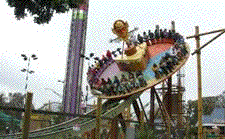

I went to California's Great America on a Sunday back in 2006. Two purposes: 1) to collect data with Vernier's new Wireless Dynamic Sensor System (WDSS), and 2) to look over the new ride with a view towards writing an activity appropriate for the CD and for our website. Although the ride looked like a lot of fun, it didn't present me with lots of great, clean physics that led naturally to worksheet calculations. I have several items below, but most are qualitative and semiquantitative. Use them in some mixture as it benefits your class.
Measurements:
How many passengers at one time? _________Time from one loading to the next? __________
How many passengers per hour? ___________
Radius of the riders on their platform: __________
Period of the platform rotation: _________
Calculation:
Speed of a rider along the circular path around the platform: ________Centripetal acceleration: __________
Speed of the platform through the bottom of the dip: ________ Discuss how you arrived at this figure.
Observations:
What motions does a rider experience on the ride? Does the rider experience these one at a time or as some sort of combination?Is the rotational speed of the platform constant? At some times it appears to slow down then speed up. Is this an illusion or is it real?
Where along the ride would you expect to feel the largest forces? How many times would the force build up to a large force then drop down during a complete ride?
Is there a correlation between the movement of the platform along the track and the rotational motion of a rider? For example, is one rider always going backwards relative to the platform's motion?
This ride has a fairly unique seating arrangement. How does this contribute to the ride experience?
What other rides at California's Great America share similar features to Tiki Twirl? Choose two and compare and contrast the two rides.
Do it Yourself:
Observe the ride. Determine an important physical quantity that you could measure or make a good estimate. Write up a short procedure that you would carry out to do this. Then carry out your measurements and write up your work as completely as possible.
Click here to download an MS Word document that you can then modify to fit your goals and your class needs.
Updated 1/26/2012